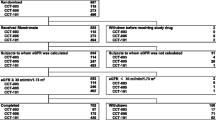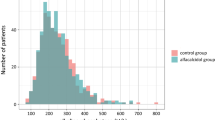Abstract
We previously observed that a creatinine clearance (CrCl) of <65 ml/min is a significant and independent risk factor for the number of fallers and falls in a community-dwelling elderly population and postulated that this increased risk is due to the associated significant lower D-hormone serum levels. To test our hypothesis, we investigated in a post hoc analysis of a double-blind randomized study whether treatment with alfacalcidol, a synthetic prodrug of the D-hormone, can reduce the high incidence of fallers and the high risk of falls associated with low CrCl. Of 378 Swiss community-dwelling women (n=191) and men (n=187), aged 70 years and older, 191 received randomly 1 μg capsules of alfacalcidol (AlphaD3: Teva), and 187 received one capsule of placebo daily. With the help of questionnaires we regularly assessed the incidence and frequency of falls. The risk of becoming a faller and the risk of falling were assessed in multivariate-controlled logistic regression models according to treatment groups and according to a CrCl cut-off of 65 ml/min. The presented results are from ITT analyses. In participants with a CrCl of <65 ml/min, the 36 weeks of treatment with alfacalcidol was, compared with placebo, associated with a significant reduction in the number of fallers (14/72 versus 25/70; OR 0.26, 95% CI 0.08–0.80, P=0.019), and a significant reduction of the number of falls (16/72 versus 28/70; OR 0.29, 95% CI 0.09–0.88, P=0.028). No such association was observed in participants with a CrCl of ≥65 ml/min (for fallers 26/120 versus 21/116; OR 0.92 95% CI 0.34–2.52, P=0.875; for falls 32/120 versus 23/116; OR 0.93 95% CI 0.34–2.54, P=0.885). In the placebo group frequency of falls was dependent on CrCl (P=0.006), whereas in the alfacalcidol treatment group frequency of falls was independent of CrCl (P=0.494). No cases of clinically relevant hypercalcemia were observed. In a community-dwelling population of elderly men and women with a CrCl of <65 ml/min, treatment with alfacalcidol can significantly and safely reduce the low CrCl associated increased number of fallers and the high risk of falls.


Similar content being viewed by others
References
Gallagher JC, Fowler SE, Detter JR et al. (2001) Combination treatment with estrogen and calcitriol in the prevention of age-related bone loss. J Clin Endocrinol Metab 86:3618–3628
Dukas L, Bischoff HA, Lindpaintner LS, Schacht E, Birkner-Binder D. Thalmann B, Stähelin HB (2004) Alfacalcidol reduces the number of fallers in a community-dwelling elderly population with a minimum calcium intake of 500 mg daily. J Am Geriatr Soc 52:230–236
Peacock M, Heyburn P (1977) Effect of vitamin D3 metabolites on proximal muscle weakness. Calcif Tissue Res 24:R20–23
Bischoff HA, Stähelin HB, Urscheler N et al. (1999) Muscle strength in the elderly: its relation to vitamin D metabolites. Arch Phys Med Rehabil 80:54–58
Verhaar HJJ, Samson MM, Jansen PAF et al (2000) Muscle strength, functional mobility and vitamin D in older women. Aging Clin Exp Res 12:455–460
Dhesi JK, Bearne LM, Monitz C, Hurley MV, Jackson SHD, Swift CG, Allain TJ (2002) Neuromuscular and psychomotor function in elderly subjects who fall and the relationship with vitamin D status. J Bone Miner Res 17:891–897
Koike T, Okawa T, Wada M, Kita T, Takaoka K (2003) Effects of a long-term alfacalcidol or calcitonin administration on body sway in Japanese elderly women. J Bone Miner Res 18:S168
Dukas L, Schacht E Bischoff HA (2003) Better functional mobility in community dwelling elderly is related to D-hormone and a minimal calcium intake of more than 512 mg/day. Osteoporos Int 14:S34
Tinetti ME, Williams CS (1998) The effect of falls and fall injuries on functioning in community-dwelling older persons. J Gerontol A Biol Sci Med Sci 53:M112–M119
Tinetti ME (2003) Preventing falls in elderly persons. N Engl J Med 348:42–49
Nevitt MC, Cummings SR, Hudes ES (1989) Risk factors for recurrent nonsyncopal falls: a prospective study. JAMA 261:2663–2668
Sattin RW (1992) Falls among older persons: a public health perspective Annu Rev Public Health 13:489–508
Willet W (1998) 1980 Nurses’ health study dietary questionnaire. In Nutritional epidemiology, 2nd edn. Oxford University Press, Oxford
Winer BJ (1971) Statistical principles in experimental design, 2nd edn. McGraw-Hill, New York, p 514
Poor G, Atkinson EJ, O’Fallon WM et al. (1995) Predictors of hip fracture in elderly men. J Bone Miner Res 10:1900–1907
K/DOQI (2003) practice guidelines for bone metabolism and disease in chronic kidney disease Am J Kidney Dis 42:S7–S9
Epstein S, Bryce G, Hinman JW et al. (1986) The influence of age on bone mineral regulating hormones. Bone 7:421–425
Tsai KS, Heath H III, Kumar R et al. (1984) Impaired vitamin D metabolism with aging in women: possible role in pathogenesis of senile osteoporosis. J Clin Invest 73:1668–1672
Dukas L, Bischoff HA, Schacht E et al. (2002) Normal 25(OH) vitamin D serum levels do not exclude D-hormone deficiency in community-dwelling elderly. Osteoporos Int 13:S35
Slovik DM, Adams JS, Neer RM et al. (1981) Deficient production of 1,25-dihydroxyvitamin D in elderly osteoporotic patients. N Engl J Med 305:372–374
Zofkovà I, Kancheva RL, Bendlovà B (1997) Effect of 1,25(OH)2 vitamin D3 on circulating insulin-like growth factor-I and β2 microglobulin in patients with osteoporosis. Calcif Tissue Res 60:236–239
Cappola AR, Xue Q_L, Ferrucci L, Guralnik JM, Volpato S, Fried LP (2003) Insulin-like growth factor I and interleukin-6 contribute synergistically to disability and mortality in older women. J Clin Endocrinol Metab 88:2019–2025
Stein MS, Wark JD, Scherer SC, Walton SL, Chick P, Di Carlantonio M, Zajac JD, Flicker L (1999) Falls related to vitamin D and parathyroid hormone in Australian nursing home and hostel. J Am Geriatr Soc 47:1195–1201
Boland R (1986) Role of vitamin D in skeletal muscle function. Endocr Rev 784:434–448
Endo I, Inoue D, Mitsui T, Umaki, Y, Akaike M, Yoshizawa T, Kato S, Matsumoto T (2003) Deletion of vitamin D receptor gene in mice results in abnormal skeletal muscle development with deregulated expression of myoregulatory transcription factors. Endocrinology 144:5138–5144
Acknowledgements
We are indebted to the participants and all our study co-workers; to the team from the laboratory of Rheumatology at the Felix-Platter Spital, Basel, Switzerland as well as to the team of the Hospital Pharmacy of the Kantonsspital, Basel, Switzerland; to Professor John Orav (Division of Clinical Epidemiology, Brigham and Women’s Hospital, Boston, USA) for statistical consultation and advice; to Dr. A. Monsch for advice and encouragement in the preparation of the study protocol and study conduct. The study was supported by the following institutions: TEVA Pharmaceuticals Industries Ltd, Israel and a scientific grant from the University Hospital Basel, Switzerland.
Author information
Authors and Affiliations
Corresponding author
Rights and permissions
About this article
Cite this article
Dukas, L., Schacht, E., Mazor, Z. et al. Treatment with alfacalcidol in elderly people significantly decreases the high risk of falls associated with a low creatinine clearance of <65 ml/min. Osteoporos Int 16, 198–203 (2005). https://doi.org/10.1007/s00198-004-1671-9
Received:
Accepted:
Published:
Issue Date:
DOI: https://doi.org/10.1007/s00198-004-1671-9




